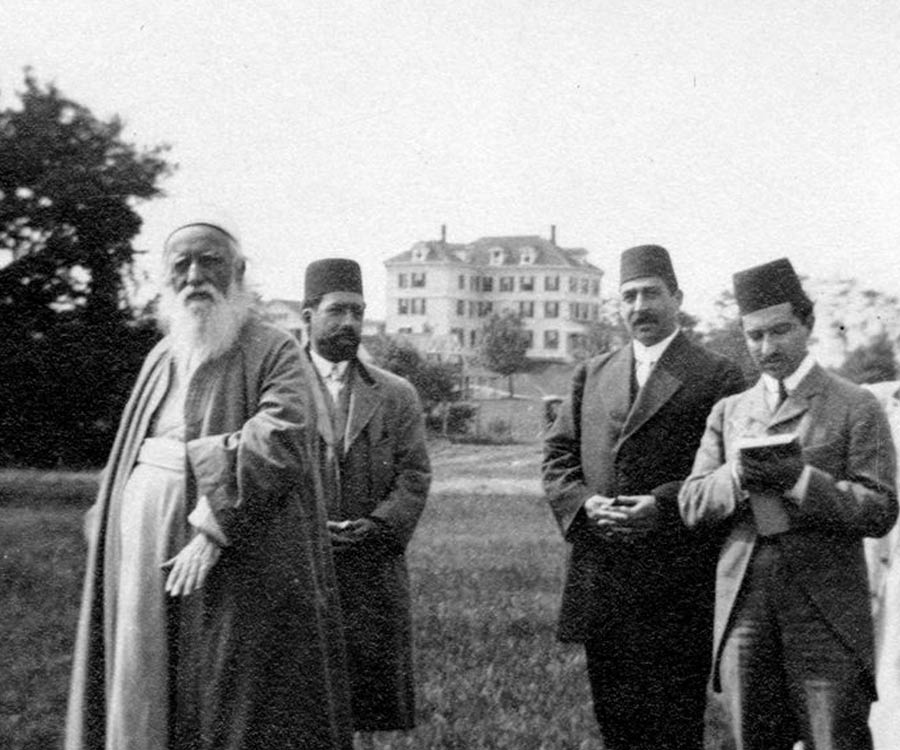The views expressed in our content reflect individual perspectives and do not represent the authoritative views of the Baha'i Faith.
Some days ago I returned from my seven-hour drive back from Green Acre Baha’i School in Eliot, Maine, just a few miles from the still-quaint city of Portsmouth, New Hampshire.
Green Acre, as Baha’is lovingly refer to it, is in God’s country. It offers beautiful forested glens, a sparkling river, fresh air unlike humid New Jersey where I live, and cool, invigorating, sun-filled breezes in spring and summer. Baha’is from all over the world visit the spot. Part of its charm is its remoteness in small-town America, nestled in towering pines and dappled fields of dewy grasses.
One of Green Acre’s attractions is that the Master himself, the indefatigable Abdu’l-Baha, visited and stayed at its 50-room inn in August, 1912. The Inn, opened in 1890 by founder Sarah Farmer and a group of investors, was intended as a retreat and center of interfaith discourse by the leaders and prominent personages of the day, an oasis for relief from the crowded confines of city tenements. The Farmers were Transcendentalists who were associated with the Abolitionists and other progressive movements. Their home was a way station on the Underground Railroad. Sarah Farmer grew up knowing influential writers, inventors and thinkers of her day, including John Greenleaf Whittier, Harriet Beecher Stowe, and Sojourner Truth.

Abdu’l-Baha at Green Acre (1921)
In 1892, Sarah Farmer had a vision that the facility should offer conferences on progressive subjects like the sciences, arts and religion, universal in scope and open to all races and creeds. Over time, these conferences brought together leading writers, educators, philosophers, artists and activists. In 1894, under a tent banked by fragrant pines, Sarah Farmer dedicated Green Acre to the ideals of peace and religious unity as she founded the “Green Acre Conferences.” There she raised the world’s first known peace flag, which measured 36 feet long. In 1896 the Monsalvat School for the Comparative Study of Religion, a progressive development seen against conservative religious experience, was established as an institution hosted at Green Acre. Monsalvat was named after the sacred mountain in Wagner’s Parsifal, where the Holy Grail was kept. In 1900, after visiting the ‘Abdu’l-Baha in Akka, Palestine, Farmer devoted herself to the Baha’i Cause until her death in 1916, having turned over its operation to the Baha’is three years earlier.
Since those early days Green Acre has functioned as a school, a place of pilgrimage and a nature-filled refuge for Baha’is and their families, friends and spiritual seekers. Thousands have attended classes there, all promoting universal religious and humanitarian values within a Baha’i context.
I first attended in 1972 with my wife and friends, to facilitate study of Shoghi Effendi’s indispensable treatise on Baha’i beliefs titled The Dispensation of Baha’u’llah. Green Acre drew us back almost every year—we would return to teach different subjects and visit almost every summer thereafter, and were blessed to meet, greet, and listen to wonderful and knowledgeable Baha’i teachers and scholars.
The great theme that runs through all of Green Acre’s charms, and indeed, in my opinion its greatest assets, are learning, transformation, and service to the world of humanity. One cannot help but be happy and caring of others needs while at Green Acre, in keeping with what Abdu’l-Baha said when he visited the United States:
But—praise be to God!—this banquet and this assemblage are for none other purpose than love, for the purpose of announcing the divine Kingdom, for the manifestation of the ineffable traces of God, for reflecting the effulgences of the Kingdom of God, for binding hearts together, for service to the world of humanity, for the promulgation of humanitarian and altruistic realities, for the advancement and advocating of international peace, for the illumination of the whole world. – The Promulgation of Universal Peace, p. 419.
As I said earlier, I have just returned from Green Acre, working and serving in the dining room and kitchen during stays by various groups from a dozen to almost 80 people. Bonnie the Manager, Head Cook, meal planner and preparer; Tom, the general cook and assistant manager; Julie; Ann and I, together ran the operation for both permanent and temporary staff meals and those of guests. It was the hardest, most demanding physical labor I’ve ever performed—except for tarring roofs when I was 17. Green Acre operates with volunteers in order to keep costs reasonable for attendees of all ages. But besides the obvious advantages to just being on the property and staying at the Inn, I did get to have unlimited private sessions alone, on the porch under the many stars, alone in the pines, and alone in Abdu’l-Baha’s room; just talking to God, Baha’u’llah and Abdu’l-Baha in my prayers.
Green Acre, you see, is not a place. It is a great throbbing heart of love, pouring its universal spirit into every soul, mind, body and spirit that steps into its environs. It is a holy place, not only because Abdu’l-Baha stayed there in one of the rooms of the Inn, but because the spirit of happiness there is simply contagious and ever-present.
When he visited Green Acre, Abdu’l-Baha said, “May everyone point to you and ask, ‘Why are these people so happy?’ I want you to be happy in Green Acre, to laugh, smile and rejoice in order that others may be made happy by you.” – Ibid., p. 218.
There is no place like Green Acre because Green Acre is not a place: it is a condition. I encourage you to register for a session, volunteer, or just visit, before there’s no room left at the inn.
Go to Greenacre.org for more details.

















Comments
Sign in or create an account
Continue with Facebookor